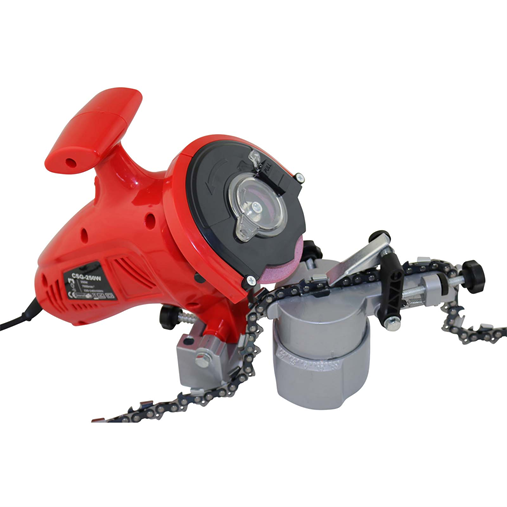Chainsaws are one of the most essential tools for cutting through wood and other tough materials. However, they can't run smoothly without regular maintenance. Like any sharp tool, chainsaws require periodic sharpening to ensure optimal performance. Neglecting this simple task can lead to dull blades and less efficient cutting. Failing to maintain your chainsaw by not sharpening it regularly can result in uneven or jagged cuts. This not only makes your job more difficult but also puts extra strain on your arms and body. A good chainsaw sharpener is crucial for keeping your blade in top condition and ensuring safe, effective operation. Here's everything you need to know about how to sharpen a chainsaw, when to do it, and what types of sharpeners to choose. Sharpening chainsaw chains is often overlooked by many users, especially those who aren't familiar with proper maintenance. While chainsaws are powerful machines, their effectiveness depends on well-maintained blades. Different types of chains require different levels of attention. For example, full chisel chains have squared teeth that need frequent sharpening, while semi-chisel chains last longer before needing touch-ups. A dull chainsaw is not only inefficient but also dangerous. If the blade isn't sharp enough, it may struggle to cut through the material, leading to messy results. In the worst-case scenario, a dull chain can cause kickback, which happens when the chain gets stuck and then dislodges unexpectedly. This can be very hazardous, potentially causing injury. A properly sharpened chainsaw significantly reduces the risk of such incidents and improves overall safety during use. A well-sharpened chainsaw performs much better than a dull one. It can cut through wood quickly and cleanly, making your work easier and more efficient. Additionally, a sharp blade requires less effort from the engine, which can save fuel over time. Whether you're cutting firewood or trimming branches, a sharp chainsaw will make the job faster and more precise. Maintaining your chainsaw through regular sharpening helps extend its lifespan. A dull chain is more likely to get damaged when it gets caught on hard surfaces. Regular sharpening also allows you to inspect the chain for wear and tear, helping you catch issues early. Plus, a sharp blade doesn’t put as much strain on the engine, which means your chainsaw will last longer overall. Knowing when to sharpen your chainsaw is just as important as knowing how to do it. You don’t need to sharpen it every time you use it, but there are certain signs that indicate it’s time for maintenance. Consider these three factors: Have you hit something hard? Is the saw performing as expected? And when was the last time you used it? These questions can help determine if it's time to sharpen your chainsaw. If your chainsaw hits a rock, metal, or even dirt, it could damage the blade. Hitting hard objects can dull the teeth or even break them. If the chain is intact, you can usually restore it to its original condition with proper sharpening. If your chainsaw has been stored for a long time, it might need sharpening before you use it again. Even if you sharpened it before storing, it's a good idea to check and re-sharpen if needed. This ensures that the blade remains in good condition and ready for use. If you notice that your chainsaw is taking longer to cut through wood or is producing rougher cuts, it may be time for a sharpening session. With regular use, you’ll start to recognize when the blade is losing its edge and needs attention. There are two main options for sharpening your chainsaw: hand filing and machine filing. Each has its own advantages and drawbacks, so choosing the right one depends on your skill level and preferences. Using a manual chainsaw file gives you complete control over the process. It requires some experience and knowledge of proper angles and grinding techniques. If done correctly, hand filing can produce excellent results. However, mistakes can worsen the condition of the blade, so it's important to be careful. Machine sharpeners are designed to simplify the process. They come with pre-set angles and guides, making it easier for beginners to achieve consistent results. Electric models are available in various voltages, such as 12V or 240V, and offer convenience and efficiency. Reading reviews can help you find the best option for your needs. Choosing the right chainsaw sharpening tool depends on several factors, including whether you prefer a manual or electric model. Some brands offer higher quality and reliability than others. The key is to maintain your chainsaw regularly to avoid accidents and ensure long-term performance. JONO & JOHNO is Australia's top online supplier of chainsaw parts and accessories. We carry a wide range of tools, from sharpeners to lawn equipment. If you're unsure which chainsaw chain sharpener to buy, call us today! Our team is here to help you find the perfect solution for your needs. Sealing Ring,Us Air Air Compressor,General Air Compressor,Small Air Compressors Permanent Machinery Co., Ltd. , https://www.jshjcompressor.com
The Importance of Chainsaw Sharpening
1. Safety
2. Better Performance
3. Prolongs the Lifespan of Your Chainsaw
When to Sharpen a Chainsaw Chain
1. When You Hit Something Hard
2. When You Haven't Used the Equipment for Months
3. When It's Obviously Duller Than Usual
Hand Filing or Machine Filing?
Hand Filing
Machine Filing
Browse Our Selection of High-Quality Chainsaw Sharpeners